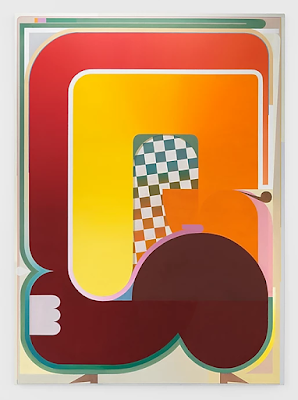COLOR RUSH: THE PAINTINGS OF BERNARD BUHMANN
When Clement Greenberg first espoused the notion of flatness in art, he
never suspected it might find its most ideal model in computer screens,
which can display color in a pure form unadulterated by the marks of
gesture or the illusion of depth. This was decades away from his
knowledge. One can trace the paintings of Bernhard Buhmann at Marinaro Gallery
all the way back to Barnett Newman, Al Held, and Morris Louis. Hiis
painterly constructions achieve a hybrid state in which a sort of
lackadaisical geometric layering meets a subtle anthropomorphism aided
by his titles. The paintings take two sizes, one nearly monumental and
the other intimate.
Of his larger paintings, I chose Twister and The Chatterbox,
2019, both with oil on canvas, measuring 79 by 57 inches. Buhmann has
an esthetic affinity for the proscriptive appeal of right angles,
especially as they can be used to delineate borders and peripheries
creating spatial tension, into which he can then introduce pictorial
motifs that create, despite the overall flatness of application, an
impression of layering and depth. His titles add context and humor to
the viewer’s experience. In Twister we have a large painting
measuring nearly six feet across by nearly seven feet. The large bands
of strong color that encircle it originate near its lower center with
burgundy so dark it’s nearly black; and moving clockwise in a rapturous
almost serpentine fashion, it alternates to red, orange, and yellow. At
the center, which is painted separately, with a faded lighting, is a
checkered field, like a tablecloth or tiled floor. Buhmann likes to lend
his painted constructions a degree of entity or agency, so here he adds
a pipe, two feet, and one hand, all minimally depicted, as if by
afterthought. The Chatterbox is organized not in a circular
fashion but has plates of distinct colors stacked one atop the other, as
if to imply the superficial characterization of this particular
portrayal. This character also has feet and a pipe, but the color plates
are organized so as to give a face to it that is more overtly depicted.
One eye of green stares directly at the viewer, while the other, of
blue, droops, as if closed or looking askance. Below the eyes the mouth
area is also in green, and a mouth sticks open, as if in continuous
chatter, a thin line of orange giving it a macabre appeal similar to
Phud from The Beatles’ cartoon extravaganza “Yellow Submarine” (1968).
 |
| "The Chatterbox" (2019), Oil on canvas, 79 x 57 inches |
Of the two examples that exemplify Buhmann’s smaller paintings, there are Model S and Mad Man,
both with Oil on canvas, measuring 27 ½ by 16 ⅛ inches; one from 2019,
the latter from 2020. These are even more visually complex. The first
has more sections, and its not meant as a person but a vehicle, with
wheels below where feet usually are. Despite this effort it still comes
off as implying an entity of sorts, although that is perhaps more a
product of perception. It’s inherently difficult to give ourselves over
to pure matter except when we have no choice. If we can project some
semblance of our own proprietary agency, we will. Therefore a window
becomes an eye, a wiper becomes an arm; and a light shining from within
becomes intelligence or mere consciousness. Either way it is beautifully
painted with shades of sky blue, turquoise, purple, grey-green, and
umber all denoting separate areas or constituent parts.
 |
| "Model S" (2019), Oil on canvas, 27 ½ by 16 ⅛ inches |
Mad Man does the most with the least detail and the most amount of mood. We have another wheeled figure, separated into upper and lower hemispheres, a solid real green below, and above globular forms at the midsection which could either imply eyes or breasts, we have a progressively fading degree of the same color, suffused by an aura of pinkish orange, creating a tension between a very male color associated with military khakis or lockers in barracks, and one that is more associated with women’s makeup or colorful summertime clothing. As the dark area fade upwards, they lose all hardness, and at the top is a pinkish sun gazing down.
Buhmann’s characters, if they are to be seen as such, are in a way
Miroesque, appearing at first like abstract fields of color that
transform into complex visual constructions replete with areas that fade
and evolve into other colors, creating a narrative of mood within a
single figure. The peripheral details that fill them out into discrete
entities serves to make them altogether more ambiguous. In Buhmann’s
universe hard edges contain colors that dictate behavioral responses,
and when they are less hard, or made more pictorially ambivalent, they
slacken to allow the viewer control in the pleasure of their perception.


Comments